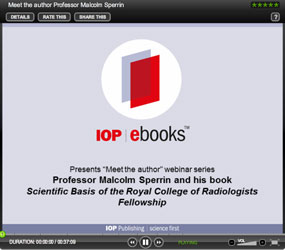The IOP ebooksTM "Meet the author" webinar series gives you the chance to get to know our authors, as well as the research behind their latest book.
In our latest webinar, Professor Malcolm Sperrin, Director of Medical Physics, Royal Berkshire NHS Foundation Trust, talks about his new book, Scientific Basis of the Royal College of Radiologists Fellowship: Illustrated questions and answers.
He shows us sample questions and detailed solutions and there is a live Q&A session at the end.
Read some of the Q&As from the webinar:
Where is medical science heading?
This is a huge area, but I would say that there are two areas of focus at the moment that go hand in hand.
The first is improved image quality and that we are developing new techniques to enhance the resolution. In nuclear medicine, for example, image quality is at worst a few centimetres and at best, 5–10 mm. We need to improve this.
The other area is the appreciation of risk. One area that I am very keen to look at is the reduction in radiation dose by enhancing the performance of things such as detectors. To drive down the radiation doses and have greater understanding of risk and reduce that risk to the patient and staff is of great importance.
How can we diagnose diseases, such as cancer, at early stages?
There are two ways of diagnosing cancers and tumours. One is histopathology where you are taking the tissue and examining it under a microscope, but that assumes that it has been suspected or diagnosed in some way.
The other way of determining whether or not a cancer is present is to use what is known as functional imaging, such as nuclear medicine, which uses a drug that is going to be preferentially absorbed where the metabolism is evaluated. Cancerous tumours grow because of an enhanced reproduction rate of the cells and so the metabolism is raised and the particular drug will localise on that site. Because it is giving off gamma rays, you can image that using a gamma camera.
The problem with nuclear medicine is that it tends to be a low-resolution technique and the cancer has to be of an appreciable size before it becomes detectable. However, there is a drive to enhance that resolution and find alternative techniques for the localisation and identification of those cancers. It is a huge area.
Why can't we have automated improvement of image quality?
Automation is a very interesting concept and many people are looking at it, but we're not there yet. The problem with automated improvement is that if you improve an image in some way, then there is some other aspect of the image that you're sacrificing for that, and we cannot be 100% certain that it is accurate. So if you were to enhance the contrast in an image, you would be sacrificing grayscales or resolution. But what you can do is to look at the core data of an image where you've maximised the contrast and then find some other way of improving it for your own specific diagnostic purposes. This is not automated image enhancement but a conscious effort to improve an image based on what you see. This happens all of the time and in my department, for instance, we use what is known as the window level to adjust and display those features that we are interested in seeing.
Which medical professions are most reliant on medical science?
The medical profession now is becoming increasingly scientific and if we want to take an X-ray for example, we need to understand how the X-ray interacts with the patient and why the image forms as it does. The actual outcome of that X-ray becomes one for the doctors to be able to diagnose from, but the actual process for getting that X-ray relates to quality and risk is very much one of a physical process. Essentially, we need to understand the science behind it.
Professions that are highly reliant on medical science include radiology as well as obstetricians and gynaecologists. I've done a lot of work with the Royal College of Obstetricians and Gynaecologists, and they want to know, for example, what techniques should be used for imaging a developing foetus. In this instance, computed tomography (CT) is sometimes used but you would usually go for something like magnetic resonance imaging (MRI). Even in the case of MRI, the reaction of the foetus to the magnetic fields and the changing field gradients is not fully understood.
All professionals in the medical sciences need to be familiar with the risks in order to improve both therapeutic and diagnostic procedures.
